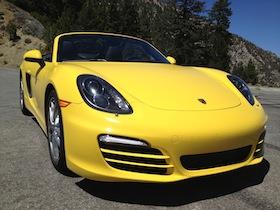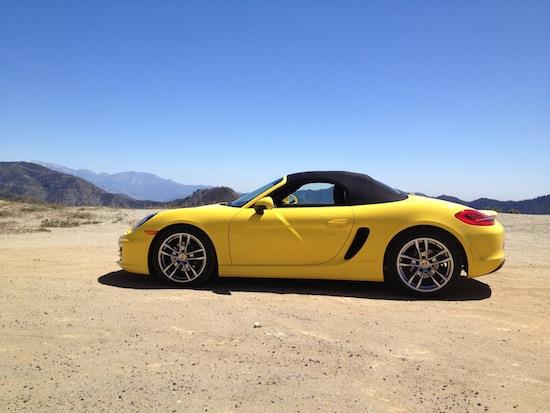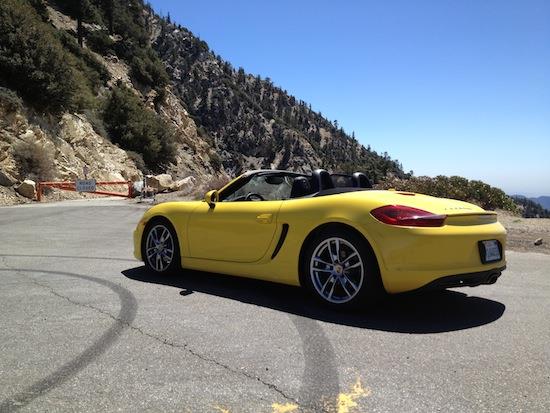 Take a look at any of your favorite automotive websites – including this one – and you could swear that Porschedoesn’t make a base model car anymore. All you'll see are “S” versions. It seems as though we journalists never get a chance to drive Porsche’s base model cars, and with a week in Los Angeles, I was determined to try.
Take a look at any of your favorite automotive websites – including this one – and you could swear that Porschedoesn’t make a base model car anymore. All you'll see are “S” versions. It seems as though we journalists never get a chance to drive Porsche’s base model cars, and with a week in Los Angeles, I was determined to try.
Two things are immediately apparent when you approach the2013 Porsche Boxster. The first is that it is gorgeous. Even in Los Angeles, the Racing Yellow exterior stands out, with its matching yellow seatbelts adding just the right amount of levity as an accent. The interior as a whole is great, too, like all new Porsche interiors. The newest version of the Boxster sees a design finally coming of age, with a cohesive mix of aggression and elegance lacking in previous models.
The second thing you notice is how expensive the Boxster is. The spec sheet showed that the base model I was testing was just over $63,000 with destination. Included in the handling department for that price are 19-inch wheels, Porsche Torque Vectoring and Porsche Active Suspension Management. This makes the 2013 Boxster one seriously sticky car on the mountain roads just north of L.A. But the easy handling has caused me to develop a gripe.

With handling being equal, the 265-horsepower 2.7-liter six-cylinder in the Boxster -- recently awarded one of the "Engines of the Year" -- doesn’t feel up to task like the 315-horsepower 3.4-liter unit in the Boxster S. So there’s a mismatch in the base car. In the S, Porsche’s systems and aides have a lot more potential speed to work with as they find balance with the car’s sizable power. In the entry-level Boxster, the abilities of the suspension far outstrip the available power, and if anything, only serve to constantly remind you of all the things it can’t do.
Taking the 2013 Boxster into the canyons revealed its greatest flaw with even more clarity. It feels like this Boxster could carve every corner and slice apexes at will, if only the power was there to make the most of its excellent chassis. As it is, you have to seriously rev up the Boxster to wring any real power out of it (the 206 lb-ft of torque might have something to do with that; compared with the 266 lb-ft in the Boxster S).
When you’re flying, it rewards you with incredible handling, though the new electric power steering does lose some feel from the old setup. As much as I’d like to, however, I can’t blame the electric steering for the Boxster’s synthetic feel when performing at anything less than its absolute limits. Look at an Audi S4, where the suspension systems and electric steering all work together to harness its power and make for an exhilarating experience. In the Boxster, the power simply isn’t there to pull these elements together the way they’re meant to be.

At city speeds, these issues don’t present themselves as dramatically. You just notice how nice it looks and feels inside while everyone around you admires how good it looks on the outside. I’d take the 2013 over the old model mostly based on the new design alone.
But I can’t help but wonder if the base model – without these suspension goodies, and with smaller 18-inch wheels – would have been a better-balanced droptop in the mountains. If you cut out a couple of the expensive assists and suspension pieces and axe the big 19-inch wheels, maybe the price would come down to a reasonable level for a really good roadster that doesn’t need to spit fire to feel alive. For now, if you’re considering the new Boxster, the S is the only way to go: for your $60,000-plus you might as well get the model with a power level that's perfect for the superior abilities of its chassis and suspension.
 All photos by the author.
All photos by the author.
James Tate cut his teeth in the business as a race-team crew member before moving to the editorial side as senior editor of Sport Compact Car, and his work has appeared in Popular Mechanics, Automobile, Motor Trend and European Car. When not writing, Tate is usually fantasizing about a vintage Porsche 911.
 Take a look at any of your favorite automotive websites – including this one – and you could swear that Porschedoesn’t make a base model car anymore. All you'll see are “S” versions. It seems as though we journalists never get a chance to drive Porsche’s base model cars, and with a week in Los Angeles, I was determined to try.
Take a look at any of your favorite automotive websites – including this one – and you could swear that Porschedoesn’t make a base model car anymore. All you'll see are “S” versions. It seems as though we journalists never get a chance to drive Porsche’s base model cars, and with a week in Los Angeles, I was determined to try.
Two things are immediately apparent when you approach the2013 Porsche Boxster. The first is that it is gorgeous. Even in Los Angeles, the Racing Yellow exterior stands out, with its matching yellow seatbelts adding just the right amount of levity as an accent. The interior as a whole is great, too, like all new Porsche interiors. The newest version of the Boxster sees a design finally coming of age, with a cohesive mix of aggression and elegance lacking in previous models.
The second thing you notice is how expensive the Boxster is. The spec sheet showed that the base model I was testing was just over $63,000 with destination. Included in the handling department for that price are 19-inch wheels, Porsche Torque Vectoring and Porsche Active Suspension Management. This makes the 2013 Boxster one seriously sticky car on the mountain roads just north of L.A. But the easy handling has caused me to develop a gripe.

With handling being equal, the 265-horsepower 2.7-liter six-cylinder in the Boxster -- recently awarded one of the "Engines of the Year" -- doesn’t feel up to task like the 315-horsepower 3.4-liter unit in the Boxster S. So there’s a mismatch in the base car. In the S, Porsche’s systems and aides have a lot more potential speed to work with as they find balance with the car’s sizable power. In the entry-level Boxster, the abilities of the suspension far outstrip the available power, and if anything, only serve to constantly remind you of all the things it can’t do.
Taking the 2013 Boxster into the canyons revealed its greatest flaw with even more clarity. It feels like this Boxster could carve every corner and slice apexes at will, if only the power was there to make the most of its excellent chassis. As it is, you have to seriously rev up the Boxster to wring any real power out of it (the 206 lb-ft of torque might have something to do with that; compared with the 266 lb-ft in the Boxster S).
When you’re flying, it rewards you with incredible handling, though the new electric power steering does lose some feel from the old setup. As much as I’d like to, however, I can’t blame the electric steering for the Boxster’s synthetic feel when performing at anything less than its absolute limits. Look at an Audi S4, where the suspension systems and electric steering all work together to harness its power and make for an exhilarating experience. In the Boxster, the power simply isn’t there to pull these elements together the way they’re meant to be.

At city speeds, these issues don’t present themselves as dramatically. You just notice how nice it looks and feels inside while everyone around you admires how good it looks on the outside. I’d take the 2013 over the old model mostly based on the new design alone.
But I can’t help but wonder if the base model – without these suspension goodies, and with smaller 18-inch wheels – would have been a better-balanced droptop in the mountains. If you cut out a couple of the expensive assists and suspension pieces and axe the big 19-inch wheels, maybe the price would come down to a reasonable level for a really good roadster that doesn’t need to spit fire to feel alive. For now, if you’re considering the new Boxster, the S is the only way to go: for your $60,000-plus you might as well get the model with a power level that's perfect for the superior abilities of its chassis and suspension.
 All photos by the author.
All photos by the author.
James Tate cut his teeth in the business as a race-team crew member before moving to the editorial side as senior editor of Sport Compact Car, and his work has appeared in Popular Mechanics, Automobile, Motor Trend and European Car. When not writing, Tate is usually fantasizing about a vintage Porsche 911.
No comments:
Post a Comment